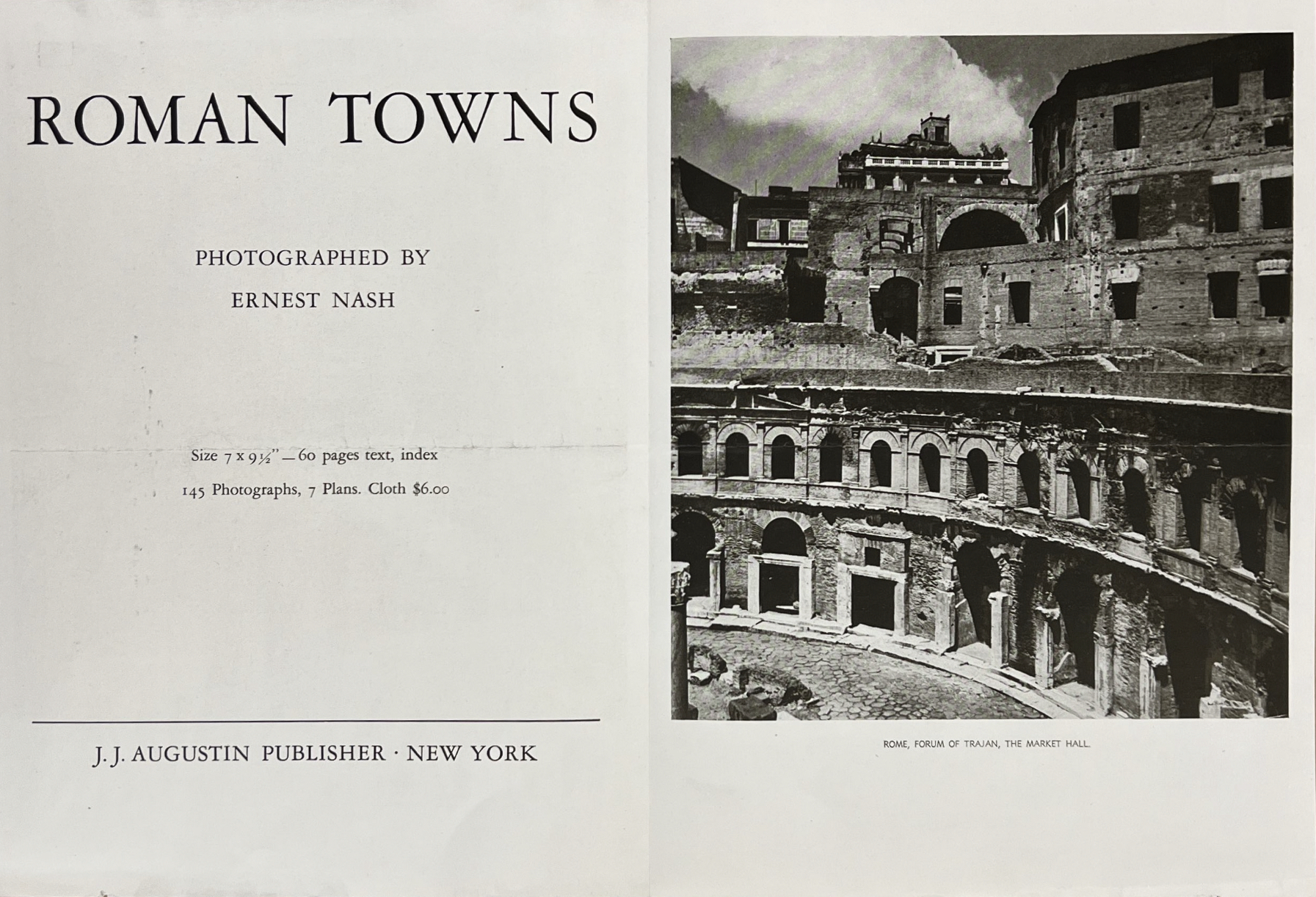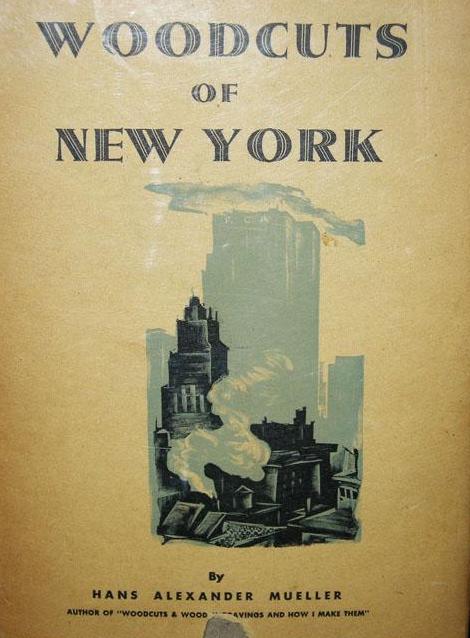Archive
J.J. Augustin Incorporated Publisher
- J.J. Augustin Incorporated Publisher
- Publishing House
J.J. Augustin was a German publishing house in Glückstadt with a long history, going back to 1632. In 1936 the American branch opened in New York with a large artistic and cultural focus.
Word Count: 33
30 Irving Place, Union Square, Manhattan, New York City (1936–1942); 125 East 23rd Street, Gramercy Park, Manhattan, New York City (1942–1948); 445 West 41st Street, Midtown West (1948–1951).

Logo and imprint of J.J. Augustin Publishing (Photo: Helene Roth). 
Book cover of Hoyningen-Huene’s photobook Hellas (J.J. Augustin, 1944). 
Announcement of Roman Towns by Ernest Nash (J.J. Augustin, 1944). 
Cover of Ballet by Alexey Brodovitch (J.J. Augustin, 1945). 
Book cover Return to Life through Contrology by Joseph Pilates (J.J. Augustin, 1945). 
Cartoon Map of New York City. Designed by Henry E. Salloch. (J.J. Augustin, 1938). 
Book cover Woodcuts of New York by Hans Alexander Mueller (J.J. Augustin, 1938). Alföldi, Maria R., and Margarita C. Lahusen, editors. Ernest Nash – Ernst Nathan: 1898–1974. Photographie Potsdam, Rom, New York, Rom. Nicolai, 2000.
Anonymous. “Book review.” The New Yorker, 10 June 1944, p. 78.
Bau, Christian, and Artur Dieckhoff, editors. Zwiebelfische. Jimmy Ernst, Glückstadt – New York. Schwarze Kunst, 2010.
Bernsohn, Al. “Picture Books of the Months: ‘Hellas’ and ‘Egypt’ photographed by Hoyningen-Huene.” Popular Photography, April 1933, pp. 28–31; 85–88.
Cosulich, Berenice. “The Literary Latern.” Arizona Daily Star, 6 November 1938, p. 22.
Eyes on Paris. Paris im Fotobuch 1890 bis heute, edited by Hans-Michael Koetzle, exh. cat. Haus der Photographie in den Deichtorhallen, Hamburg, 2011.
Grebe, Stefanie. “Vom Buch an die Wand – Ein Fotobuch als Ausgangsmaterial für eine Fotografieausstellung.” Gedruckte Fotografie. Abbildung, Objekt und mediales Format (Visuelle Kultur. Studien und Materialien, vol. 10), edited by Irene Ziehe and Ulrich Hägele, Waxmann, 2015, pp. 171–183.
Nissen, Karl. 350 Jahre Buchdrucker in Glückstadt. Karl Nissen, 1982.
Parr, Martin, and Gerry Badger. The Photobook: A History, vol. 1. Phaidon, 2004.
Seeber, Ursula, et. al., editors. Exilforschung. Ein internationales Jahrbuch, vol. 33: “Kometen des Geldes” Ökonomie und Exil. edition text + kritik, 2015.
Ziehe, Irene, and Ulrich Hägele, editors. Gedruckte Fotografie. Abbildung, Objekt und mediales Format (Visuelle Kultur. Studien und Materialien, vol. 10). Waxmann, 2015.
Word Count: 279
Word Count: 7
- 06-12-1936
- 1950
- New York
- Helene Roth. "J.J. Augustin Incorporated Publisher." METROMOD Archive, 2021, https://archive.metromod.net/viewer.p/69/2948/object/5145-9978435, last modified: 04-05-2021.
-
Hermann LandshoffPhotographerNew York
Besides outdoor fashion shots, Hermann Landshoff was a portrait and street photographer. During his time in New York, he captured the cultural, artistic and intellectual émigré scene as well as his photographer colleagues.
Word Count: 33
Alexey BrodovitchPhotographerArt DirectorGraphic DesignerNew YorkAlexey Brodovitch was a Belarus-born émigré graphic artist, art director and photographer who, from 1933, worked in New York for Harper’s Bazaar magazine and at the New School for Social Research.
Word Count: 31
Rolf TietgensPhotographerEditorWriterNew YorkRolf Tietgens was a German émigré photographer who arrived in New York in 1938. Although, in the course of his photographic career, his artistic and surrealist images were published and shown at exhibitions, his work, today, is very little known.
Word Count: 39
Ernest NashPhotographerArchaeologistLawyerNew YorkErnest Nash was a German born photographer, who pursued his photographic as well as an archeologic interest in Roman architecture after his emigration to New York in 1939. Besides this research interest, he also worked as a portrait photographer and publisher.
Word Count: 40
Chinatown U.S.A.PhotobookNew YorkChinatown U.S.A. is a photobook published by the German émigré photographer Elizabeth Coleman in 1946 focusing on American-Chinese communities in New York and San Francisco.
Word Count: 26
5th AvenuePhotobookNew York5th Avenue was the first photobook by Fred Stein and was created in 1947 with the publishing house Pantheon Books.
Word Count: 19
Schocken BooksPublishing HouseNew YorkSchocken Books was a publishing house established in 1945 in New York by the Russian émigré Salman Schocken (1898–1959). It specialised in books on Judaica and Hebrew topics.
Word Count: 26
Pantheon BooksPublishing HouseNew YorkPantheon Books was a publishing house founded in 1942 by the German émigré Kurt Wolff (1887–1963) and aimed at the exiled European community in New York.
Word Count: 24
Querido Inc.Publishing HouseNew YorkFritz H. Landshoff’s Querido publishing house was originally an offshoot of Emanuel Querido's Querido Uitgeverij Dutch publishing house in Amsterdam. Querido Verlag was created in 1933 to publish work by German political exiles.
Word Count: 33
Fred SteinPhotographerLawyerNew YorkAlways accompanied by his camera, the German émigré photographer Fred Stein discovered New York City during the 1940s and 1950s. His pictures provide an human and multifaceted view of the metropolis.
Word Count: 31
Marion PalfiPhotographerNew YorkMarion Palfi was a German émigré photographer who lived in New York from the 1940s to the 1960s. Her photographic engagement in social and political topics made her name for her use of the camera to draw attention to social injustices.
Word Count: 41
Tim GidalPhotographerPublisherArt HistorianNew YorkTim Gidal was a German-Jewish photographer, publisher and art historian emigrating in 1948 emigrated to New York. Besides his teaching career, he worked as a photojournalist and, along with his wife Sonia Gidal, published youth books.
Word Count: 35
Lilo HessPhotographerNew YorkThe German émigré Lilo Hess was an animal photographer working for the Museum for Natural History and the Bronx Zoo, as well being a freelance photographer and publisher of children's books.
Word Count: 31
YllaPhotographerNew YorkYlla was an Austrian-born photographer who emigrated to New York in 1941. Specialising in animal photography, she produced not only studio photographs, but also shot outside on urban locations in the metropolis.
Word Count: 31
Henry RoxPhotographerSculptorNew YorkHenry Rox was a German émigré sculptor and photographer who, in 1938, arrived in New York with his wife, the journalist and art historian Lotte Rox (née Charlotte Fleck), after an initial exile in London. Besides his work as a sculptor, he began creating humorous anthropomorphised fruit and vegetable photographs.
Word Count: 50
Oceana PublicationsPublishing HouseNew YorkOceana Publications Inc was a publishing house specialising in law and civil rights founded by the British émigré Philip F. Cohen (1911–1998) in 1945.
Word Count: 22
New School for Social ResearchAcademy/Art SchoolPhoto SchoolUniversity / Higher Education Institute / Research InstituteNew YorkDuring the 1940s and 1950s emigrated graphic designers and photographers, along with artists and intellectuals, were given the opportunity to held lectures and workshops at the New School for Social Research.
Word Count: 31
Norlyst GalleryGalleryArt GalleryNew YorkFounded in 1943 by the American painter and art collector Elenore Lust, the Norlyst Gallery represented a cross section of contemporary painting, photography and other media focusing on surrealist and abstract expressionist styles and promoting women artists and photographers.
Word Count: 38